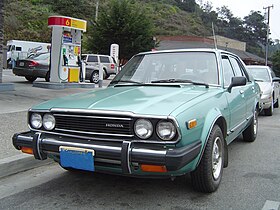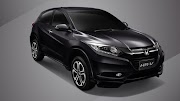HONDA ACCORD FIRST GENERATION (1976-1981)
  | ||
Hatcback
|
The first-generation Honda Accord was launched on 7 May 1976, as a three-door hatchback with 68 hp (51 kW), a 93.7-inch (2,380.0 mm) wheelbase, and a weight of about 2,000 pounds. Japanese market cars claimed 80 PS (59 kW) JIS (similar to SAE Gross), while European and other export markets received a model without emissions control equipment; it claimed 80 PS as well but according to the stricter DIN norm. It was a platform expansion of the earlier Honda Civic at 4,125 mm (162 in) long. To comply with gradually tightening emission regulations enacted in Japan, the engine was fitted with Honda's CVCC technology. The Accord sold well due to its moderate size and great fuel economy. It was one of the first Japanese sedans with features like cloth seats, a tachometer, intermittent wipers, and an AM/FM radio as standard equipment. In 1978 an LX version of the hatchback was added which came with air conditioning, a digital clock, and power steering. Until the Accord, and the closely related Prelude, power steering had not been available to cars under two liters. Japanese buyers were liable for slightly more annual road tax over the smaller Civic, which had a smaller engine.
On 14 October 1977, (a year later in the U.S. market), a four-door sedan was added to the lineup, and power went to 72 hp (54 kW) when the 1,599 cc (97.6 cu in) EF1 engine was supplemented and in certain markets replaced by the 1,751 cc (106.9 cu in) an EK-1 unit. Technically, the sedan was not changed from the hatchback, and the wheelbase remained the same as well. This did result in a rather long rear overhang to fit a full-sized trunk. The roof was a bit taller so as to provide more interior comfort, and the Accord Sedan was the first Honda in Japan to be offered with typically Japanese middle-class extras such as ornate hubcaps and lace seat covers.
In the U.S. market, the sedan was available in two colors: silver with maroon cloth interior or dark red with maroon cloth interior. In 1980 the optional two-speed semi-automatic transmission of previous years became a three-speed fully automatic gearbox (a four-speed automatic transaxle was not used in the Accord until the 1983 model year). The North American versions had slightly redesigned bumper trim. Other changes included new grilles and taillamps and remote mirrors added on the four-door (chrome) and the LX (black plastic) models. The CVCC badges were deleted, but the CVCC induction system remained.
In North America, the 1981 model year only brought detail changes such as new fabrics and some new color combinations. Nivorno Beige (code No. Y-39) was replaced by Oslo Ivory (No. YR-43). Dark brown was discontinued, as was the bronze metallic. A bit later in 1981 an SE model was added for the first time, with Novillo leather seats and power windows. Base model hatchbacks, along with the four-door, LX, and SE four-door, all received the same smaller black plastic remote mirror. The instrument cluster was revised with mostly pictograms which replaced worded warning lights and gauge markings. The shifter was redesigned to have a stronger spring to prevent unintentional engagement of reverse, replacing the spring-loaded shift knob of the 1976 to 1980 model year cars. By 1981 power for the 1.8 was down to a claimed 68 hp (51 kW) in North America.
| Production | 1976–1981 |
|---|---|
| Model years | 1977–1982 |
| Assembly | Sayama Plant, Sayama, Saitama, Japan North Jakarta, Indonesia (PT. Prospect Motor) Johor Bahru, Malaysia (OASB)[ |
| Body and chassis | |
| Class | Compact car |
| Body style | 3-door hatchback 4-door sedan |
| Powertrain | |
| Engine | 1.6 L EL1 I4 1.6 L EF I4 1.6 L EP I4 1.8 L EK1 I4 |
| Transmission | 2-speed automatic 3-speed automatic 5-speed manual |
| Dimensions | |
| Wheelbase | 2,380 mm (93.7 in) sedan |
| Length | 4,450 mm (175.2 in) sedan |
| Width | 1,620 mm (63.8 in) sedan |
| Height | 1,360 mm (53.5 in) sedan |
| Curb weight | 945 kg (2,083 lb) |












0 Comments